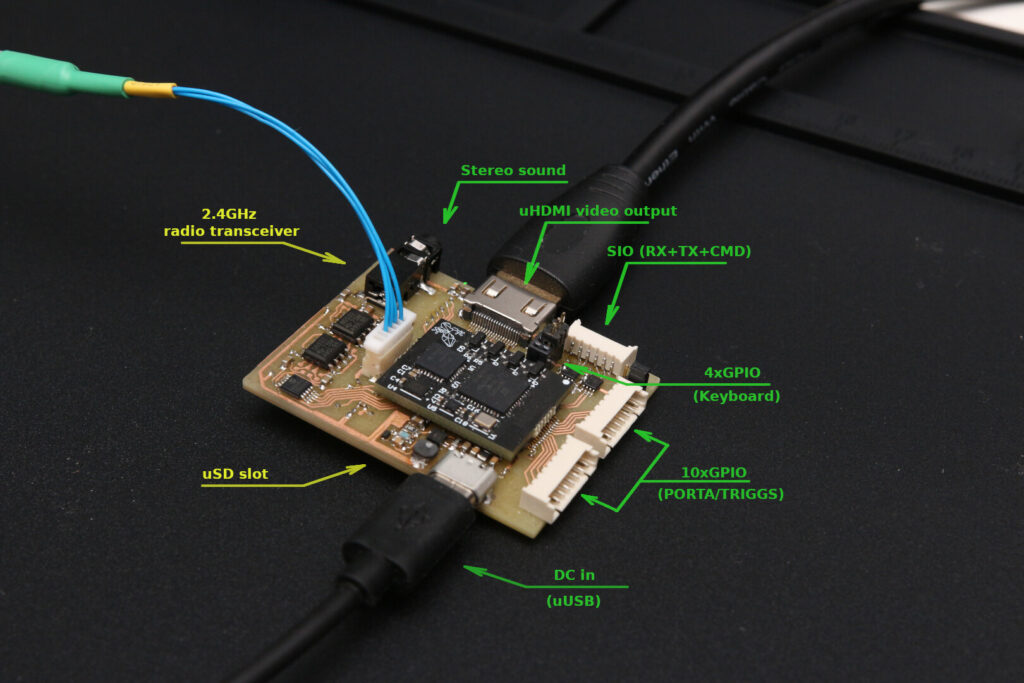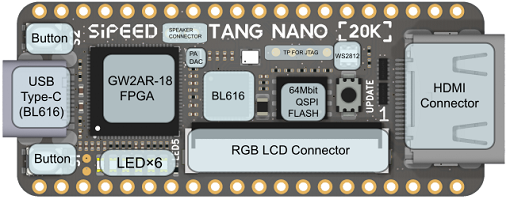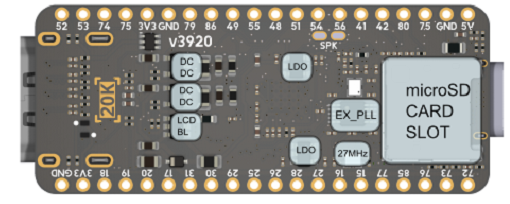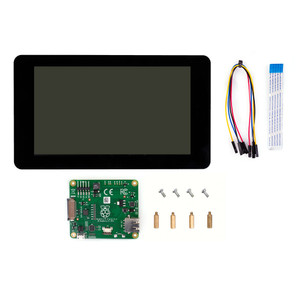| Poster | Thread |
 DiscreetFX DiscreetFX
 |  |
Tiniest Amiga in the world, please stand up!
Posted on 4-Jun-2025 2:32:13
| | [ #1 ] |
|
|
 |
Elite Member
 |
Joined: 12-Feb-2003
Posts: 2555
From: Chicago, IL | | |
|
| |
| Status: Offline |
|
|
 BigD BigD
|  |
Re: Tiniest Amiga in the world, please stand up!
Posted on 4-Jun-2025 7:15:28
| | [ #2 ] |
|
|
 |
Elite Member
 |
Joined: 11-Aug-2005
Posts: 7578
From: UK | | |
|
| @DiscreetFX
Brilliant! What an achievement! Star Raiders on a stamp sized PCB! _________________
"Art challenges technology. Technology inspires the art."
John Lasseter, Co-Founder of Pixar Animation Studios |
|
| Status: Offline |
|
|
 pavlor pavlor
|  |
Re: Tiniest Amiga in the world, please stand up!
Posted on 4-Jun-2025 16:28:58
| | [ #3 ] |
|
|
 |
Elite Member
 |
Joined: 10-Jul-2005
Posts: 9695
From: Unknown | | |
|
| @DiscreetFX
Well, the netbook I use when travelling is quite small, but not even close to this Atari.  |
|
| Status: Offline |
|
|
 matthey matthey
|  |
Re: Tiniest Amiga in the world, please stand up!
Posted on 4-Jun-2025 20:45:38
| | [ #4 ] |
|
|
 |
Elite Member
 |
Joined: 14-Mar-2007
Posts: 2778
From: Kansas | | |
|
| DiscreetFX Quote:
Personally, I do not believe this is so impressive because the AntarinoPico module does not have I/O ports. This makes the module like a SoC or MCU chip but a chip is smaller. The chip package is usually much larger than the chip itself too. The AntarinoPico module did not allow for a tiny I/O board either.

The FleaFPGA Ohm uses a RPi Zero form factor (65x30mm) so results in a smaller SBC with I/O, has better I/O with the addition of USB, has a larger more powerful FPGA, allows a 68020+AGA Amiga even though it is tight and was available for $45 USD.

While this may be good for universal retro FPGA hardware and provides a usable retro 16/32-bit computer system although not enough performance to sell well, a SoC/MCU could make it cheaper, smaller and much more powerful. The $4 USD RPi Pico is smaller at 51x21mm and the MCU reduces the parts while still leaving minimal I/O of USB and GPIO.

The MCU is less than $1 USD in quantity available as a commodity and used in other products like the SparkFun Pro Micro which has an option for up to 8MiB of external PSRAM, more than enough for an Amiga.

https://en.wikipedia.org/wiki/RP2040
https://en.wikipedia.org/wiki/RP2350
The original RPi pico RP2040 MCU uses more transistors than a 68060&AA+ chipset because of the MCU SRAM instead of DRAM like a SoC. The newer RP2040 MCU has 520kiB SRAM which is enough for an Amiga yet it is still under $1 USD depending on how much NOR flash is wanted which is like an EPROM back in the Amiga times but can be updated without removal (some Amiga accelerators use NOR nonvolatile memory for MapROM).
More integrated is cheaper and higher performance but standard I/O may be lost. The RPi Zero form factor and I/O is more usable than the RPi Pico form factor and I/O for most people. With a 68k SoC, it would likely be possible to have a RPi Zero form factor with similar CPU performance to a PPC X5000 for about the same price as the FleaFPGA Ohm and below $100 USD anyway. The big question is the memory. The RPi Pico MCU uses SRAM which is what caches are usually made out of so it is like the whole system is cached which is very consistent too but also limited as SRAM uses more power than DRAM. The most integrated solution is to provide eDRAM on the SoC/MCU chip. The FleaFPGA Ohm uses external DRAM which provides flexibility in selecting the size but takes board space. The memory cost raises the price when several GiB of memory are required and wasted for a fat ISA like PPC or a 64-bit ISA like AArch64. Lean and mean is where the Amiga and AmigaOS compete the best but the Amiga industrial complex prefers fat, noncompetitive and expensive while delegating the 68k Amiga to 2nd class citizen as a virtual Amiga. Jay Miner had the vision of what integration would allow the Amiga to do but then Commodore, Motorola and the current Amiga industrial complex decided they knew better.
Last edited by matthey on 04-Jun-2025 at 10:00 PM.
|
|
| Status: Offline |
|
|
 amigang amigang
|  |
Re: Tiniest Amiga in the world, please stand up!
Posted on 5-Jun-2025 10:00:23
| | [ #5 ] |
|
|
 |
Elite Member
 |
Joined: 12-Jan-2005
Posts: 2146
From: Cheshire, England | | |
|
| |
| Status: Offline |
|
|
 minator minator
|  |
Re: Tiniest Amiga in the world, please stand up!
Posted on 5-Jun-2025 11:24:37
| | [ #6 ] |
|
|
 |
Super Member
 |
Joined: 23-Mar-2004
Posts: 1038
From: Cambridge | | |
|
| |
| Status: Offline |
|
|
 matthey matthey
|  |
Re: Tiniest Amiga in the world, please stand up!
Posted on 5-Jun-2025 18:16:50
| | [ #7 ] |
|
|
 |
Elite Member
 |
Joined: 14-Mar-2007
Posts: 2778
From: Kansas | | |
|
| amigang Quote:


The Tang Nano is a nice RPi Pico form factor SBC that makes very good use of the board space and adds several valuable I/O features including for display (TMDS/HDMI for monitors and DSI for direct LCD control). The display options are closer to what would be wanted for an Amiga Pico form factor. Funny enough, this Chinese business has a Maix "Amigo" SBC with dual RISC-V cores. The Tang Nano FPGA is a let down though, stopping just short of having good support for the 16-bit generation of retro consoles/computers and the FPGA is from a Chinese supplied business. It would get more interesting if they introduced a Tang Nano 25k or Tang Nano 30k with a little larger FPGA.
amigang Quote:
The Tang Primer 25k FPGA is larger and more powerful but I do not like the two board design and it does not have as much I/O.
amigang Quote:
To be honest, I always felt the Raspberry pi Credit Card size is about as small as I would go, as it about the size where can you still have room for all the ports and connections.
That being said I do understand why smaller is cooler, one idea i had when I first saw Pi Zero, was to build an Amiga emulation system within a CD32 Controller, I sure it would be possible, still think it be a fun little project, but I dont know if I will ever get around to doing it.
|
An all in one CD32 controller is easier today than in the past like the C64 Direct-to-TV.

https://en.wikipedia.org/wiki/C64_Direct-to-TV
The C64 Direct-to-TV uses a C64 SoC ASIC like Jeri Ellsworth was near completing for the Amiga too. It is not very compact as the RPi Pico form factor Tang Nano 25k can do much of what the C64 Direct-to-TV and OCS/ECS 68000 Amiga can do that Jeri worked on. The Tang Nano 25k is more flexible. The DSI port opens up many new options like handheld devices.

https://www.pishop.us/product/game-hat-for-raspberry-pi/
Uses RPi Zero form factor and HDMI so no DSI required and may work with the FleaFPGA Ohm. The resolution may be too low for good Amiga support but there may be others on the market. A DSI connection may allow accessories like this to be cheaper.
Touch screen smartphone size gaming devices.

https://www.pishop.us/product/pimoroni-raspberry-pi-7-touchscreen-display-frame-noir/
Cell and WiFi phone capabilities could be added to create an Amiga smart phone.
Touch screen tablets.

https://www.pishop.us/product/official-raspberry-pi-7-touch-screen-display-with-10-finger-capacitive-touch/
And with a little more work, netbooks and laptops could be produced. Touch screen support, battery support and low power features would be required for some of these devices and accessories but these are not rocket science. Universal FPGA SBCs can already do much of this and can be produced for a very low price like the FleaFPGA Ohm at $45 USD but they give low end MiniMig like hardware when even the 68k Amiga hardware demand is for higher performance hardware (the FleaFPGA did not sell well but it could have been promoted better and backed by Amiga businesses). A 68k SoC with 68060@1-2GHz cores would blow away 68k and low footprint hardware users, could be passively cooled and use very little memory. RPi is practically being forced to 64-bit AArch64 by ARM for standard hardware and most Linux installs with a GUI use ~512MiB of memory just to boot up where the 68k Amiga can easily boot into a GUI with less than 512kiB of memory. The smallest RPi Pico devices do not even have a GUI but use MicroPython like early 6502 family computers used BASIC even though the RPi Pico 2 has enough memory for the AmigaOS with a GUI, not that the Pico has video output but an Amiga with that form factor could even with games. ARM is abandoning their standard 32-bit Thumb ISA Cortex-A support and small footprint standard hardware which the Amiga has. This is creating an opportunity for RISC-V as well as can be seen by the increased use of RISC-V cores in small footprint devices in China, as I mentioned above. The 68k has better code density and allows a smaller footprint than RISC-V while performance metrics/traits are better. There is an opportunity to bring back the 68k but the dinosaur Hyperion A-EonKit Syndicate is still pushing fat PPC on the desktop with nowhere near competitive features or value while sabotaging the 68k where it could be competitive and despite the fact the 68k AmigaOS saved Hyperion from bankruptcy and AmigaKit likely survives off the 68k Amiga while using Amiga IP they do not own. Even the syndicate knows the 68k Amiga market is the only viable market but they hold it hostage waiting for the opportunity to go away. Another lost Trevor Amiga decade and there will be no more Amiga opportunity!
minator Quote:
This MCU is tiny but likely only one of the 2 smallest 8-pin packages of the 7 package options. The chip itself is likely smaller. For ease of assembly and soldering, the package number of pins and pitch of pins is often limited for the hobbyist SBCs. Integration reduces the package pins but the MCU/SoC price is very important for the embedded market too.
Last edited by matthey on 05-Jun-2025 at 06:45 PM.
Last edited by matthey on 05-Jun-2025 at 06:36 PM.
Last edited by matthey on 05-Jun-2025 at 06:19 PM.
|
|
| Status: Offline |
|
|
 cpaek72 cpaek72
|  |
Re: Tiniest Amiga in the world, please stand up!
Posted on 23-Jun-2025 21:17:30
| | [ #8 ] |
|
|
 |
New Member
|
Joined: 3-Feb-2015
Posts: 6
From: Unknown | | |
|
| @DiscreetFX
Now I’m curious if someone’s managed to squeeze an Amiga into something even smaller. Maybe a Raspberry Pi project hiding in a keychain or something? |
|
| Status: Offline |
|
|
 OneTimer1 OneTimer1
|  |
Re: Tiniest Amiga in the world, please stand up!
Posted on 24-Jun-2025 6:24:38
| | [ #9 ] |
|
|
 |
Super Member
 |
Joined: 3-Aug-2015
Posts: 1272
From: Germany | | |
|
| RaspberryPi Pico isn't suitable for an Amiga emulator, 150MHz CPU is to slow Video Output is missing.
Boards like the "Tang Nano 20k" would be better, but to be successful you need someone putting it into an "Amiga" style case (beige is best) and gives it a name resembling an Amiga.
|
|
| Status: Offline |
|
|
 amigang amigang
|  |
Re: Tiniest Amiga in the world, please stand up!
Posted on 24-Jun-2025 11:37:42
| | [ #10 ] |
|
|
 |
Elite Member
 |
Joined: 12-Jan-2005
Posts: 2146
From: Cheshire, England | | |
|
| |
| Status: Offline |
|
|
 matthey matthey
|  |
Re: Tiniest Amiga in the world, please stand up!
Posted on 24-Jun-2025 17:49:29
| | [ #11 ] |
|
|
 |
Elite Member
 |
Joined: 14-Mar-2007
Posts: 2778
From: Kansas | | |
|
| OneTimer1 Quote:
RaspberryPi Pico isn't suitable for an Amiga emulator, 150MHz CPU is to slow Video Output is missing.
|
The RPi Pico RP2040 MCU with Cortex-M0+ cores has a very low power target but the RPi Pico 2 RP2354 MCU with Cortex-M33 cores is low power with the performance advantage of SRAM.
MCU Core | DMIPS/MHz
Cortex-M0+ 0.99 (https://developer.arm.com/Processors/Cortex-M0-Plus)
Cortex-M33 1.54 (https://developer.arm.com/Processors/Cortex-M33)
Cortex-M85 3.13 (https://developer.arm.com/Processors/Cortex-M85)
MPU/SoC Core | DMIPS/MHz
PPC601 1.4
PPC603e 1.4
68060 1.8
PPC440/460EX 1.8 (Sam)
MPC5200B/e300 1.9 (EfikaPPC)
PA6T 2.2 (X1000)
PPC750 2.3 (PPC G3)
Cortex-A53 2.30 (RPi 3)
QorIQ-P1022/e500v2 2.4 (A1222)
PPC970 2.9 (PPC G5)
P5020/e5500 3.0 (X5000)
Cortex-A72 5.45 (RPi 4)
Cortex-A76 6.60 (RPi 5)
The Cortex-M0+ has a 2-stage pipeline, the Cortex-M33 has a 3-stage pipeline and the Cortex-M85 has a 7-stage pipeline. All these MCU cores are scalar too yet a Cortex-M33 core is outperforming some older superscalar and OoO cores. If RPi used the Cortex-M85 in a MCU, it may have better performance/MHz than a X5000 OoO CPU core. Much of the advantage comes from SRAM memory which is like having all of memory cached. Old silicon is also a big disadvantage. These Cortex-M MCU cores are often not clocked as high as Cortex-A cores but they do not need to be. The limiting factor is more likely to be the limited amount of SRAM memory which is what makes it difficult to use for Amiga emulation, especially for JIT compilation. It should be possible to turn a 68060 and Amiga chipset into a MCU and with double the SRAM of the Pico 2, the 68000+OCS/ECS spec would we met and with quadruple the SRAM, the 68020+AGA spec would be met. I expect an 8-stage superscalar 68060 core would outperform a 7-stage scalar Cortex-M85 core when moved to newer silicon and only using SRAM memory. I expect most 68k Amiga users would want more than 2MiB of memory though even though that was the last 68k Amiga standard.
|
|
| Status: Offline |
|
|
 kolla kolla
|  |
Re: Tiniest Amiga in the world, please stand up!
Posted on 24-Jun-2025 19:00:50
| | [ #12 ] |
|
|
 |
Elite Member
 |
Joined: 20-Aug-2003
Posts: 3483
From: Trondheim, Norway | | |
|
| @matthey
Obsessed much? _________________
B5D6A1D019D5D45BCC56F4782AC220D8B3E2A6CC |
|
| Status: Offline |
|
|
 OneTimer1 OneTimer1
|  |
Re: Tiniest Amiga in the world, please stand up!
Posted on 24-Jun-2025 19:44:13
| | [ #13 ] |
|
|
 |
Super Member
 |
Joined: 3-Aug-2015
Posts: 1272
From: Germany | | |
|
| @matthey
Quote:
matthey wrote:
OneTimer1 Quote:
RaspberryPi Pico isn't suitable for an Amiga emulator, 150MHz CPU is to slow Video Output is missing.
|
The RPi Pico RP2040 MCU with Cortex-M0+ cores has ...
rhubarbrhubarbrhubarbrhubarbrhubarbrhubarbrhubarbrhubarbrhubarbrhubarbrhubarbrhubarbrhubarb rhubarbrhubarbrhubarbrhubarbrhubarbrhubarbrhubarbrhubarbrhubarbrhubarbrhubarbrhubarbrhubarb rhubarbrhubarbrhubarbrhubarbrhubarbrhubarbrhubarbrhubarbrhubarbrhubarbrhubarbrhubarbrhubarb rhubarbrhubarbrhubarbrhubarbrhubarbrhubarbrhubarbrhubarbrhubarbrhubarbrhubarbrhubarbrhubarb rhubarbrhubarbrhubarbrhubarbrhubarbrhubarbrhubarbrhubarbrhubarbrhubarbrhubarbrhubarbrhubarb rhubarbrhubarbrhubarbrhubarbrhubarbrhubarbrhubarbrhubarbrhubarbrhubarbrhubarbrhubarbrhubarb rhubarbrhubarbrhubarbrhubarbrhubarbrhubarbrhubarbrhubarbrhubarbrhubarbrhubarbrhubarbrhubarb rhubarbrhubarbrhubarbrhubarbrhubarbrhubarbrhubarbrhubarbrhubarbrhubarbrhubarbrhubarbrhubarb rhubarbrhubarbrhubarbrhubarbrhubarbrhubarbrhubarbrhubarbrhubarbrhubarbrhubarbrhubarbrhubarb
|
NO VIDEO OUTPUT |
|
| Status: Offline |
|
|
 matthey matthey
|  |
Re: Tiniest Amiga in the world, please stand up!
Posted on 24-Jun-2025 21:46:24
| | [ #14 ] |
|
|
 |
Elite Member
 |
Joined: 14-Mar-2007
Posts: 2778
From: Kansas | | |
|
| OneTimer1 Quote:
Video output is a nice feature but so is standard hardware and a small footprint OS. It is not rocket science to add video out. It is 15 resistors and 5 capacitors with Linus Ã…kesson's schematic.
Linus Ã…kesson's Kaleidoscopico Turns a Raspberry Pi Pico 2 Into a Powerful Demoscene Machine
https://www.hackster.io/news/linus-akesson-s-kaleidoscopico-turns-a-raspberry-pi-pico-2-into-a-powerful-demoscene-machine-85b9ba713e13
This Commodore Amiga-inspired RPi Pico 2 project has better performance than most Amiga hardware using dual 32-bit RISC-V Hazard3@130MHz cores that are weaker than the Cortex-M33 cores. Unlike the 68k Amiga, it uses one of the cores to emulate a chipset like the Amiga chipset which just so happens to support 4096 colors. This could have been actual Amiga chipset emulation instead. There is still another RISC-V Hazard3@130MHz core which could emulate the 68k although there is not enough memory for JIT. It could likely emulate an original 68000@7MHz and OCS/ECS but it may only be able to provide the original Amiga 1000 256kiB of memory using the 520kB of SRAM. Again, performance is not the problem. Limited memory is the problem and the RPi Pico 2 likely could emulate a 68000 Amiga. There is 4 MiB of NOR flash for Amiga Kickstarts, code and read only data which helps to leave most of the SRAM free for the Amiga but it still may not be possible to emulate a 512kiB Amiga. Why have we not seen a RPi Pico 2 emulating a 68k Amiga? The RPi Zero product line offers better value with better performance, more memory and, yes, video output. However the small footprint RPi Zero product line with 512kiB of memory is possible because of ARM 32-bit Thumb ISAs in Cortex-A cores which is deprecated and no longer an option in new 64-bit Cortex-A cores. The main advantage of the RPi Pico is the smaller size and lower power. Cortex-M cores will still support Thumb ISAs and there are more powerful options than the Cortex-M33. A new RPi Zero SoC with Cortex-M85 cores may eventually replace current RPi Zero hardware in order to maintain Thumb ISA support. It would no longer be strictly a MCU with just SRAM but it may allow CPU caches to be configured as SRAM like the SiFive series 7 SoCs making them a MCU/SoC hybrid. One other incentive may be that Cortex-M royalties are less than Cortex-A royalties. The big problem is that maximum Cortex-M performance will likely be lower than Cortex-A53 performance when no longer using all SRAM. ARM is forcing the choice of relatively low performance Cortex-M options for small footprint hardware or high performance Cortex-A options for large footprint hardware.
Edit:
RPi Pico based original 68000 Mac 128kiB emulation project.
https://axio.ms/projects/2024/06/16/MicroMac.html
This is with the original Pico RP2040 while the new RP2354 would handle it with ease. A little more SRAM would make 512kiB retro computers possible and we would likely see more projects like this.
Last edited by matthey on 25-Jun-2025 at 03:00 AM.
|
|
| Status: Offline |
|
|
 OneTimer1 OneTimer1
|  |
Re: Tiniest Amiga in the world, please stand up!
Posted on 25-Jun-2025 8:21:13
| | [ #15 ] |
|
|
 |
Super Member
 |
Joined: 3-Aug-2015
Posts: 1272
From: Germany | | |
|
| @matthey
Quote:
matthey wrote:
Video output is a nice feature but so is standard hardware and a small footprint OS. It is not rocket science to add video out. It is 15 resistors and 5 capacitors with Linus Ã…kesson's schematic.
|
It is driven by software and will consume most of the 150MHz CPU performance. |
|
| Status: Offline |
|
|



